Well, this is the final post of 2019 and we will finish out with some snow, some Betelgeuse, Venus and Moon conjunction, and some more quantum computing and theory textbooks. Finally, as we pack our bags for the 235th meeting of the American Astronomical Society in Hawaii in January, we had to have a little fun out at our local sports bar!
But, first up, the cloudy skies and cold weather brought a little bit of snow to our local Orange County mountains. As much as we sort of miss playing in the snow and skiing down the mountain, now it is best if the snow just stays up in the mountains.
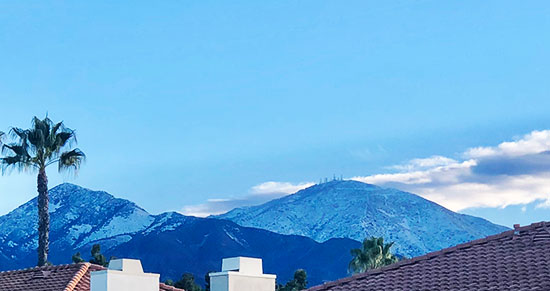 |
| Hey, snow capped local mountains in Orange County! (Source: Palmia Observatory) |
So, even with some snow, the night time skies were often clear enough to follow up on a lot of online discussion of how Betelgeuse is more dim than usual. Many commented wondering if Betelgeuse was ready to blow up, but in reality we know that Betelgeuse is a variable star and its variability, magnitude 0 to 1.3, has been tracked for years now. But, it was nice to just go outside and take a quick photo of Betelgeuse, where it is located in the upper left of the the constellation Orion.
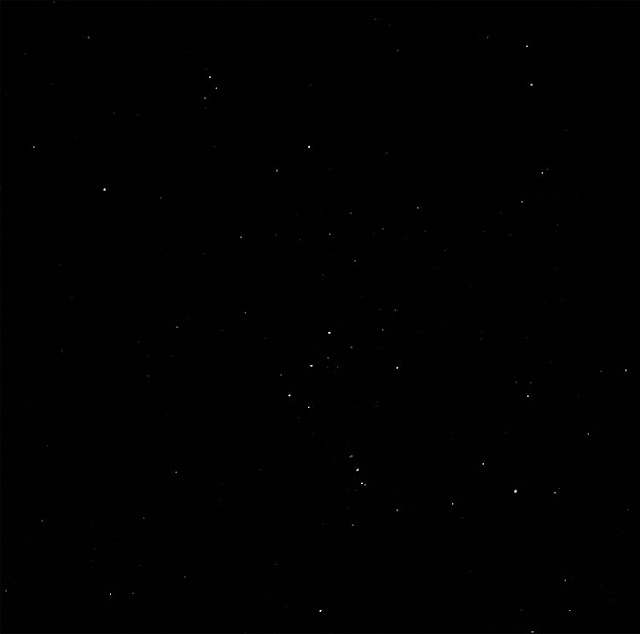 |
| Finding Betelgeuse in Orion Constellation, DSLR, 35mm, 4 seconds (Source: Palmia Observatory) |
If you are not used to spotting Betelgeuse, the following astrometric chart associated with the previous sky image is shown below. Now as much as I wanted to try again to measure the brightness of Betelgeuse, I elected not to attempt it at this time. All of you how have tried your hand at photometry in the past know that in order to measure the brightness you need to collect some flat images, using the same camera, to account for lens vignetting, and then collect some dark images and also measure the altitude of the star and some close by reference star in order to get a good measurement estimate. Hmm, that reminds me of a lot of work, so we will just continue relying on those other amateurs who have been following Betelgeuse and making all of the corrections and measurements!
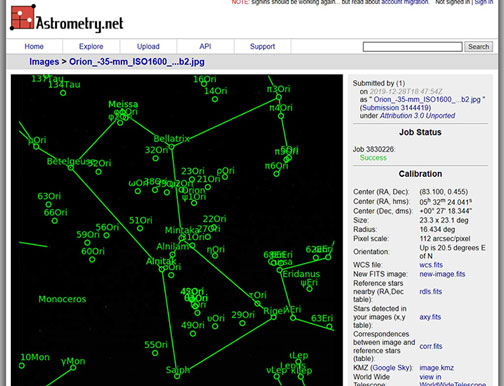 | |
|
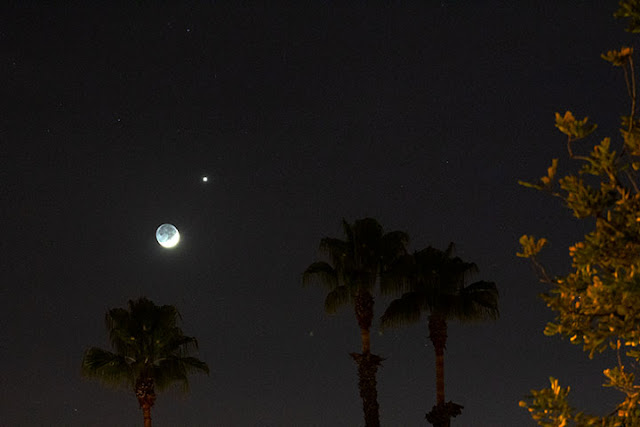 |
| Wide angle view of Moon and Venus Conjunction, DSLR, 55 mm, 1 second (Source: Palmia Observatory) |
If you zoom in on the Moon, the crescent view is very bright, but you can also start to see some of the rest of the darkened disk of the moon. I tried several exposure settings to try to capture more of the dark surface of the moon, while not overexposing the crescent moon. Using something like 1/30 second exposure seemed to be best so as not to over saturate the image. But, it was not the best to bring out the surface features of the moon. So, I settled for 1/8 second as the optimum exposure setting, shown below.
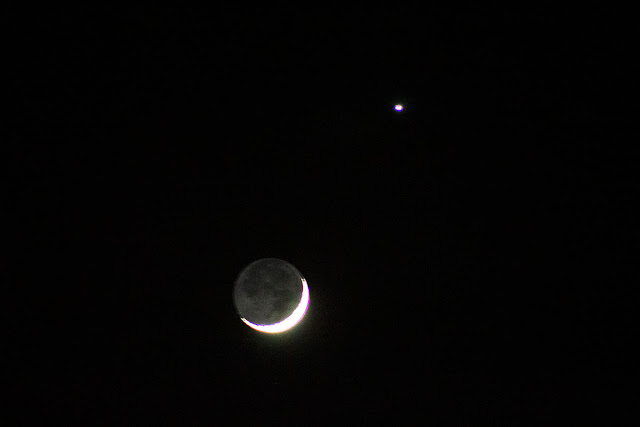 |
| Moon and Venus Conjunction, DSLR, 220 mm, 1/8 second (Source: Palmia Observatory) |
Ok, that is enough of easy, lazy astronomical observing for now, so let's get back to some physicist wannabe topics, which this week includes some comments from Legacy Coder, Larry, who responded to a previous blog post on quantum computing. In that post, I described one quantum computing textbook that illustrated how quantum computations are done in place and that quantum algorithms have to be adapted to this fact in order to take advantage of the speedup from using quantum computers. Larry recommended a couple of books dealing with this issue, one of which is the O'Reilly book shown below. The book includes code and examples that anyone can run as simulations. You can very quickly develop a sense of how quantum algorithms can work and how programming them is different from normal classical computers. I want to try some of the examples myself. Thanks for recommending that book, Larry!
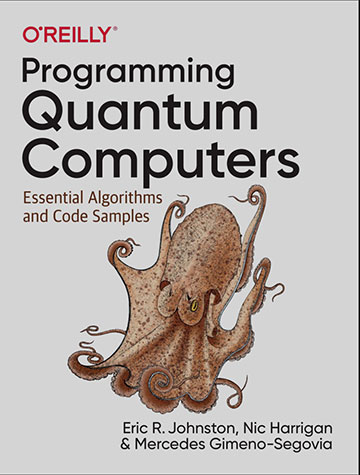 |
| Practical discussion and quantum computing code examples (Source: "Programming Quantum Computers") |
Another topic that came up that followed on this topic of quantum computing was the issue of quantum entanglement. Now ever since getting "entangled" with entanglement, most recently with Sean Carroll's book "Something Deeply Hidden", I have been going back and reviewing older textbooks to get a clearer understanding of what entanglement is all about. Ok, ok, we all remember discussions about the "spooky action at a distance" stories about how Alice does one type of quantum experiment thing on her half of an entangled pair and that somehow then determines what Bob will see when he does some similar quantum experiment on his portion of the entangled pair.
It seems that entanglement is going to become one of the cornerstone concepts in getting a deeper understanding of quantum mechanics and perhaps even quantum gravity. I was lucky to have a physics luncheon with Visionary Physicist, Dr. Don, and we talked about entanglement and measurement. Dr. Don mentioned that maybe everything gets entangled and the measurement problem is just one of understanding better how entanglement works. Hmm, thanks for that, Don!
So, while I was trying to get a more mathematical understanding of entanglement and thinking about how particles become entangled and how they then can become un-entangled, it was clear I needed to do some further research. One of the best books I have found, so far, is this book "Decoherence" by Maximilian Schlosshauer. This book has great chapters on entanglement. The entanglement of particles or systems can be easily captured in the quantum state of the system. We are all used to writing quantum states as superpositions of states and using them in doing calculations of estimates of probability of a particular type of experiment. Well, after reading some chapters of this book it becomes clear how to write down quantum states that represent entangled systems and then to do calculations to verify the degree of entanglement. Of special relevance was the discussion on reduced density matrices of pure and mixed systems and the connection to entanglement. Hmm, nothing mysterious here, the mathematics is quite clear, even though when you go back and think about the spooky action at a distance it still seems mysterious. Anyway, if you are interested in this topic, this is a great book to get started with!
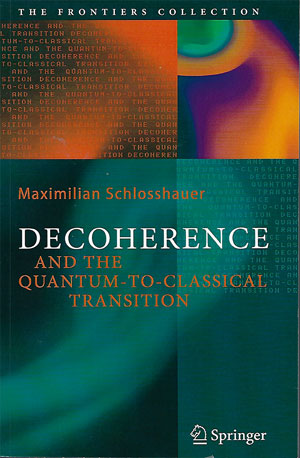 |
| Excellent discussion of decoherence and entanglement (Source: M. Schlosshauer, "Decoherence ...") |
Another great resource for getting more involved with entanglement is "Meeting the Universe Halfway" by Karen Barad. This is a great book about the interplay between philosophy and physics and has chapters on Niels Bohr's philosophy of nature and reality and the arguments with Einstein during the formation of quantum mechanic. Chapter 7 is a marvelous discussion on entanglement. Barad, is currently professor of feminist studies, philosophy, and history of consciousness at UCSC, and she has a PhD in particle physics. There is a lot of history and talk of philosophy of metaphysics, ontology and epistemology, and the impact of the observer, often assumed to be independent of the experiment, but these topics figured very much in the early history of quantum mechanics as its findings needed a new interpretation that was not possible with the Newtonian, classical physics. There is a lot of discussion about how much of reality can really be independent of the observer and how much even our culture influences what we interpret as reality. The book requires some close reading, but if you are interested in the foundations of quantum mechanics, check it out!
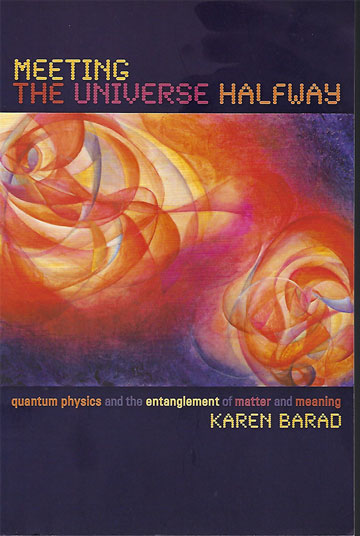 |
| Great discussion of Bohr and philosophy of entanglement (Source: K. Barad, "Meeting the Universe Halfway") |
Finally, for the last blog post of 2019, we can't but help to celebrate a little bit at our local sports bar and dream a little bit about some possible modifications to the sports bar environment. Ok, ok, I know it is just a dream, but consider what could be shown on all the TV screens. Instead of football on all seven screens, how about stuff for physicist wannabes on say five of the screens. Check out this proposed setup. What do you think?
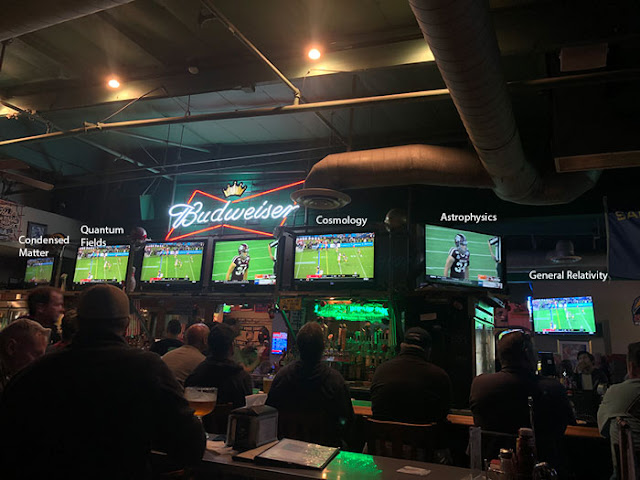 |
| Imagining sports bar redo as physicist wannabe bar? (Source: Palmia Observatory) |
Hmm, I'm not hearing a lot of positive responses, or in reality even imagining many positive responses, to this suggestion. When I asked Resident Astronomer Peggy what she thought of the idea she said something to the effect that the bar would be bankrupt and have to close down within just a couple of weeks if the modified TV channels were actually selected. Ok, ok, it was only a dream! See all the rest of you dreamers next year at the AAS meeting in Hawaii!
Happy New Year! Until next time,
Resident Astronomer George
Be sure to check out over 300 other blog posts on similar topics
If you are interested in things astronomical or in astrophysics and cosmology
Check out this blog at www.palmiaobservatory.com

No comments:
Post a Comment